The following article is based on David Brandt's presentation at the 2019 National No-Tillage Conference. To watch other presentations from the event, click here.
David Brandt knows cover crops. The Carroll, Ohio, no-tiller has been using them on his 600-acre farm since 1978 and today has a cover crop seed company to help others improve their soil health and land management practices.
When discussing interseeding — the method of seeding cover crops into a standing cash crop — at the 2019 National No-Tillage Conference, he admitted that it’s not a perfect system. He’s having about a 79% success rate with it on his own operation.
But by pairing the right cover crop species with the right seeding equipment, along with knowing how long residual herbicides are activated in the soil, no-tillers can increase their odds of having success with the practice.
Consider Herbicides
The biggest mistake Brandt sees no-tillers make with interseeding is not understanding how their herbicide program will affect their cover crops.
The first thing Brandt asks when a grower inquires about interseeding is what his herbicide program is and how long the residual is activated in the soil. Oftentimes, the grower hasn’t thought about it.
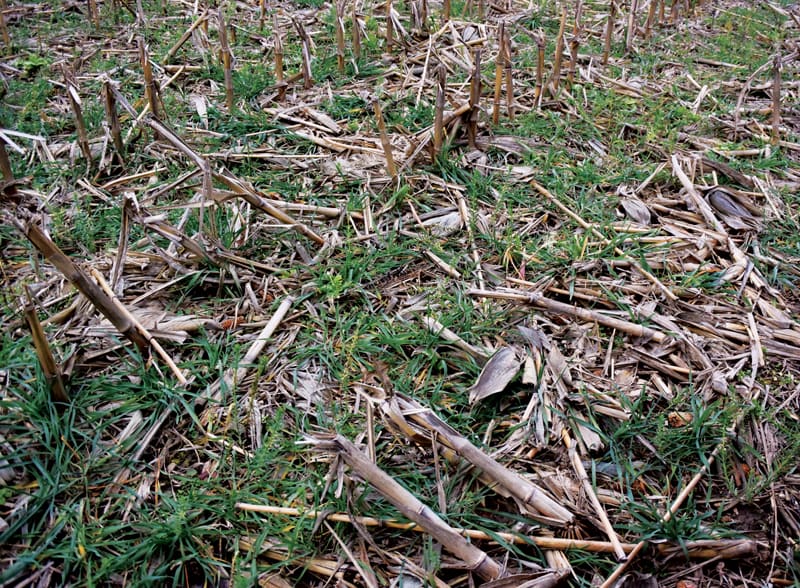
GIVE IT TIME. If you don’t see your interseeded cover crop before harvest, it doesn’t mean it’s not going to grow, David Brandt says. In this picture, the cover crop was seeded 2½ weeks before the corn was shelled. While Brandt didn’t see the cover crop when he took the corn off, it was there two weeks later. Brandt seeded a grass species to scavenge and hold soil nitrogen for the following soybean crop, to help them yield more.
“Sometimes we haven’t had success because we tend to jump into these things prior to making plans,” he says. “If you’re planning to interseed, I think it’s probably a year, year and a half away if you’re just getting started, to understand where you’ve been, what herbicides you used. I try to do that research and see how long residual herbicides last.”
For those with high soil organic matter, like 8%, Brandt estimates the herbicides will probably only last 30-40 days, while those with 0.5% may still have herbicides present for 18-24 months, depending on the products used.
Cover Crop Veteran David Brandt’s Favorite Species for Interseeding
At the 2019 National No-Tillage Conference, veteran no-tiller David Brandt shared the following cover crop cocktail that has worked the best for interseeding on his operation in Carroll, Ohio:
- 2-3 pounds of annual ryerass
- ½-2 pounds of Berseem clover
- ¾ pound of radish
- ½ pound balansa clover
Brandt recommends balansa clover because it tends to grow well in wet pockets in the field — better than any other species he’s tried. He adds that it’s a small seed with 462,000 seeds in a pound, so no-tillers don’t need to seed very many of them.
He adds that crimson and arrowleaf clovers also work well, and while he’s not a big fan of red and mammoth clovers because they don’t like the shade and are harder to establish, “if that’s all there is, that’s better than nothing.”
Birdsfoot trefoil is another one Brandt uses, and while it won’t provide much nitrogen, it tolerates the shade. However, he warns that it can linger in the field longer and may become a weed if no-tillers don’t manage it carefully.
Rape and canola are other good species for interseeding, and Brandt likes Ethiopian cabbage, especially if it’s getting later and there’s not enough time for radishes to get enough growth on them.
“If you’re in the last of September, I’d drop the radishes and put Ethiopian cabbage and rape in,” he says. “If it’s August, I’d leave those two out and use radishes.”
Multiple Seeding Methods
How a no-tiller interseeds his cover crops also plays a vital role in the success of the practice, as some methods are better than others. In his presentation, Brandt discussed several ways growers can interseed their cover crops, and some considerations to keep in mind.
Airplanes and Helicopters
One of the most common ways to interseed cover crops is by flying them on. Brandt says when he first had cover crops flown on in 1985, it was the biggest disaster he ever saw because the pilots weren’t able to fly the cover crops on where he wanted, and instead they ended up in the neighbor’s fields. But Brandt says the technology is much better today and pilots are able to place the seed where it belongs.
While most farmers will use an airplane to fly on cover crops, helicopters are another option, although Brandt says they haven’t been very successful on his operation.

SOYBEANS AS A COVER. David Brandt had soybeans blown into his standing corn crop to see if they would help build some nitrogen (N) for the corn. He says that it was about 70% successful, noting that in wet summers it seems the soybeans won’t give any N to the corn, while in dry summers the corn will take the N from the beans.
One of the reasons for this, Brandt explains, is because the helicopter will stir the air in two directions, so the seed won’t fall straight down. With an airplane, on the other hand, there’s an airflow that drives the seed toward the ground.
Flying does require a higher seeding rate — about 30% more than what a grower would use if they were drilling the cover crop, Brandt says, noting that most pilots charge a rate per acre plus the poundage they haul.
Some growers prefer to have their covers flown into their soybeans fields after a fungicide application, when the leaves are yellow and starting to drop, usually around the end of August or beginning of September. But Brandt recommends flying covers into soybeans at least 2½-3 weeks before harvest because if it rains and the grower is unable to harvest his soybeans, the cover crop still has the chance to start growing.
“We’ve had cover crops in corn 3 feet tall at harvest,” he says. “Hasn’t affected harvest.”
Interseeders on the Market
Thanks to the growing popularity of cover crops, there are equipment manufacturers who have come out with seeders specific for this practice.
“If you’re going into cornfields with 40,000 plants and they tend to be an umbrella leaf type, I wouldn’t interseed because it’s not going to get any sunlight…”
One option is Fennig Equipment’s FE4R System, a highboy sprayer that uses Hagie’s Commodity Delivery System to interseed cover crops through tubes that run in between the rows. Brandt notes that at the bottom of these tubes is a deflector on a 30-degree angle that directs the seed in both directions, creating a 10- to 12-inch band of cover crop between the rows.
Another option is Underground Agriculture’s DuoSeed, a disc opener that bolts to a high tractor bar, and when used with a seeder and fertilizer tank, can both interseed and apply fertilizer.
Penn State also developed its own interseeder, now sold through Interseeder Technologies, which interseeds three rows of cover crops in between each row of corn, while also applying post-emergent herbicides and fertilizer.
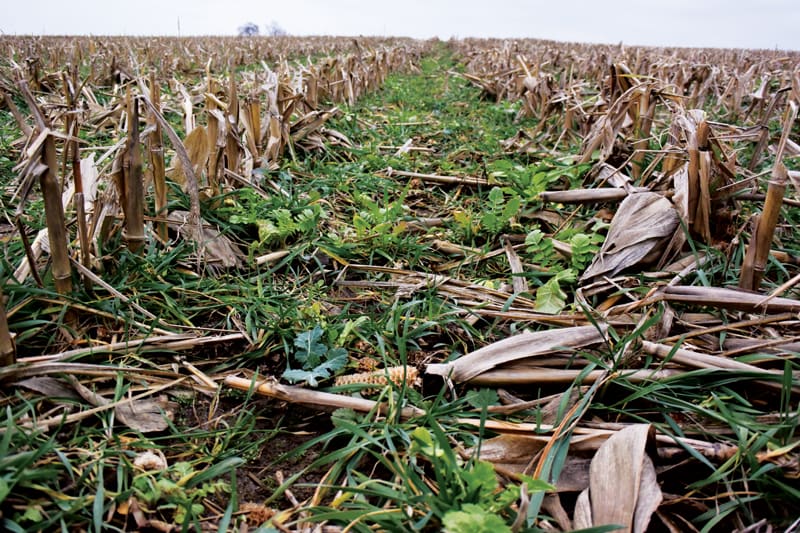
IDEAL GROWTH. This picture of radish, rye and Ethiopian cabbage after corn harvest is an example of the ideal amount of cover crop after harvest, with about 3-5 inches of growth covering the ground.
Brandt reminds no-tillers that if they go with an earlier seeding method like this, where the corn is about 2½-3 weeks old, they need to be mindful of their herbicide program.
“You can’t put 10 pounds of atrazine on it and hope to get a cover crop to grow,” he says, noting that he’s seen some farmers have cover crops taken out from residual glyphosate at that earlier stage.
Farmer Innovations
For those who don’t want to buy new equipment or hire someone to fly their cover crops on, there are plenty of ideas for building your own interseeder. Brandt shared several creative examples of interseeders growers developed themselves.
Don’t Get Greedy with Your Cover Crops
When it comes to selecting species for a cover crop mix, David Brandt recommends no-tillers always balance their legumes and grasses. He can speak from experience about the repercussions of not doing so.
Considering it to be the biggest failure he ever had, he recalls that one year he decided to seed 16 different legumes after wheat. He had a deal with USDA-ARS research soil scientist Rick Haney, inventor of the Haney soil health test, where Haney would run the tests on Brandt’s soil samples.
By October he says the legume mix looked great and there were nodules everywhere, recalling that underneath the soil it was white. He sent his sample to Haney who told him he had 1,176 pounds of nitrogen (N).
While Brandt was excited to see how his corn was going to do with all of that N in the spring, when he went to plant in early May, he couldn’t get the planter in the ground.
“We put 6 ton of suitcase weights on the corn planter,” Brandt says. “The disc blades even turned sideways.”
He called up Haney to find out what had gone wrong. Haney reminded him that in World War II, anhydrous ammonia was used to make airplane runways. The soil was hard because he didn’t have enough carbon to balance the N. He told Brandt to plant some oats, rye or any grass that would grow to get the carbon back up.
“In the last 3 years that’s been the best corn I’ve ever had, but I lost one year of production out of it,” he says. “So don’t get greedy, guys. Always balance your cover crops with grasses and legumes. You don’t have to have a whole lot of grass, but you need enough there to have that carbon to make it work for you.”
One farmer converted his Miller sprayer into an interseeder by putting an air tank on the back and Dawn seed disc openers on the front, so he could blow the seed down into the seed trench. He also had Y-Drops on so he could sidedress while interseeding.
Another setup Brandt liked was a farmer who attached a spreader on the front of his tractor, while a cultivator was pulled behind to lightly incorporate the seed. He also shared a farmer who left the coulters on a John Deere 7000 planter frame and added drill boxes, so he could both interseed and knife in his sidedress application.
“This gives you an idea of what you could look for, what you could do,” Brandt says. “Anything to save time and save trips.”
Select the Right Seed
After a no-tiller has decided when and how he’ll interseed, he has to pick a cover crop species that will match his seeding method.
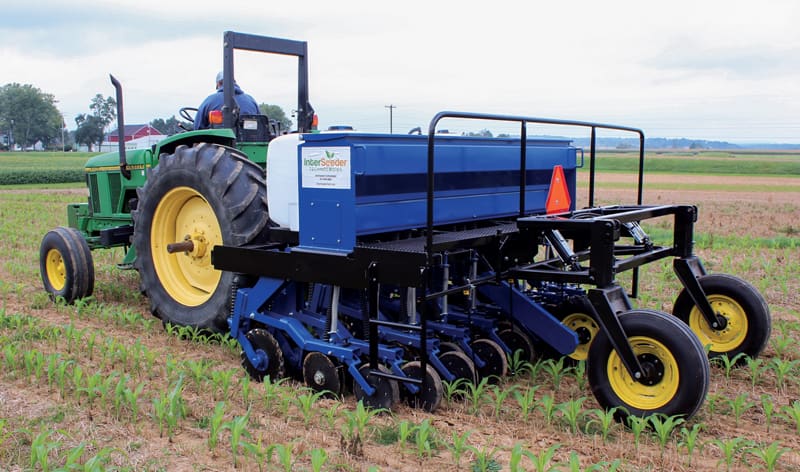
CONSIDER RESIDUALS. David Brandt reminds no-tillers who use Penn State’s InterSeeder (in image), or another tool for early interseeding, to be careful with their herbicide program, as residuals may have a negative impact on cover crop seed this early in the season. PHOTO COURTESY OF INTERSEEDER TECHNOLOGIES
If a grower is broadcasting his cover crop, Brandt says it’s hard to get big-seeded species like cereal rye, hairy vetch and cowpeas to establish because they need good seed-to-soil contact.
“The air seeder we have has a Montag airbox on it, it’s a 90-foot boom, and it has about a 35 mph wind speed at the drop,” he says. “If we happen to be in a muddy field, we could actually get some seed-to-soil contact. If it’s dry, it just bounces off the ground because it’s hard.”
For this reason Brandt recommends using smaller-seeded species that offer a higher number of seeds per pound, such as clover.
“None of this 3,000 or 4,000 seeds per pound,” he says. “Look for 300,000, 400,000, 500,000 seeds and you’ll get it to come up.”
He also recommends no-tillers avoid flying cowpeas, winter peas or faba beans into corn because it can take the leaves out. “It looks like the corn’s been hailed on,” he says.
What About Plant Growth Regulators?
At the 2019 National No-Tillage Conference, an audience member asked no-tiller David Brandt if plant growth regulators would help with the success of interseeded cover crops. Brandt says it depends on how long you’ve been using cover crops.
“If you’re in the first year or two of your cover crop program, where you’re doing interseeding to get started, yes, I think they’ll help you,” he says. “But if you’ve been in a program with cover crops for more than 4 years, they tend to be a detriment.”
He says the reason for this is because they’ll lower the “microbial herd” in the soil.
On his farm in Carroll, Ohio, Brandt says that the weight of his living soil organisms are the equivalent of four cows and four calves per acre. In January, his soils back home were 7 degrees warmer than his neighbor’s conventional fields.
“I talked to my wife and she said there was a skip of snow and there was white ground where it was conventional, and we still had green cover,” Brandt says. “She said you can’t tell it snowed on our farm. Why is that? We have a microbial herd under there creating heat, because there is a living organism.
“That’s what we’re trying to build. We’re trying to build a microbial community to help feed our crops so we can lower our purchased inputs. And it’s a slow process.”
Some of the lighter seeded species like annual ryegrass can also get caught up in the corn leaves when flown on. Brandt has seen ryegrass growing from corn because there was enough dew on the plant to germinate it. “We’ve seen ryegrass 1½-2 inches tall where the leaves are on the corn plant.”
In addition to how well a species does with a specific seeding method, no-tillers need to consider the shade tolerance of a cover crop and how tall its canopy will be. This is another reason clovers work well in interseeding, especially arrowleaf clover, because it can handle shade and doesn’t grow too high.
Annual ryegrass is another option, Brandt says, because in addition to shade tolerance, it will only grow 3-4 inches tall while its roots may reach 30 inches deep.
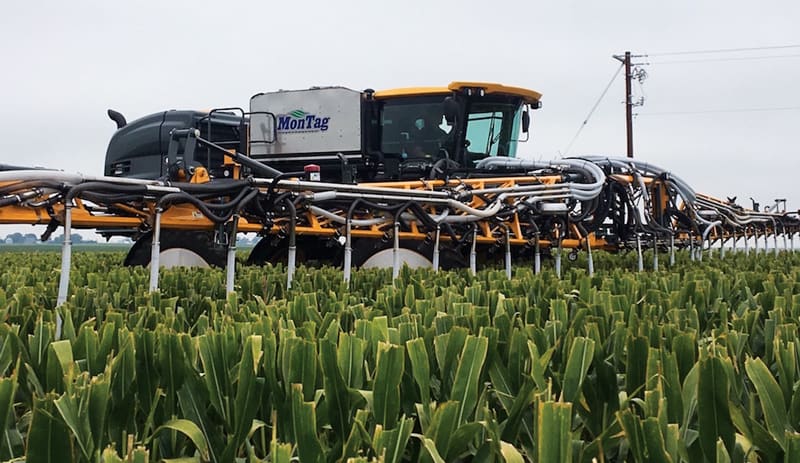
MEETING THE MARKET. While some no-tillers may prefer to build their own interseeder or hire an airplane or helicopter to fly them on, others may prefer to invest in equipment specifically designed for the practice, such as the Fortifier 2212 by Montag Mfg. and Hagie.
He adds that annual ryegrass is the only grass species he’ll use for early interseeding because of its shorter height. While Brandt does use cereal rye and oats as cover crops, he’s concerned that if he interseeded them early, with the right weather, they could end up canopying the corn.
While there are species that tolerate shade better than others, no-tillers still need to consider the density of the crop they’re seeding into.
“If you’re going into cornfields with 40,000 plants and they tend to be an umbrella leaf type, I would not do it because it’s not going to get any sunlight,” Brandt says. “If it happens to be at 32,000 or less with upright leaves and the bottom 2 or 3 leaves are yellow, you’re going to have success, especially if it rains and you’re broadcasting the cover crop.”
Because interseeding gives cover crops a longer growing period than if they were seeded after harvest, Brandt recommends using both warm- and cool-season cover crops. That way if the temperature turns hot or cool for the season, there will still be a cover crop growing.
“We’ve had cover crops in corn 3 feet tall at harvest. Hasn’t affected harvest…”
“I’m the kind of guy if we put enough out there and three things grow I’m fine,” he says. “If six of them die that’s too bad, but normally they don’t.”
Since the soil surface is typically hot and dry on Brandt’s farm in the summer, he prefers to seed warm-season legumes and grasses in his corn, noting that cowpeas will “grow like gangbusters” if they’ve had at least three-tenths of an inch of rain and 90-100 F, whereas a winter pea wouldn’t even sprout in those conditions.
“That’s why we like diversity in our covers,” he says.
Ideal Results
The goal for interseeding is to have about 3-5 inches of growth after harvest, Brandt says. He warns that how a cover crop looks in the field before harvest may not be indicative of how it’s going to turn out in the fall.
“The neat thing about all these cover crops that are interseeded is they look like crap standing in a corn and soybean field, but immediately after you shell the corn or cut the beans, those cover crops grow like gangbusters,” he says. “In a week, they’ll triple their size. In 2 weeks, they’ll be four times higher and then we’re doing some good with what’s going on.”
Brandt says that interseeding is still something he’s learning to perfect on his farm, and it will take time for no-tillers new to the practice to figure out what works best for them. He recommends growers find out what their seed dealer recommends, taking into consideration each species’ canopy height, how many leaves it has on it, and how it’s rated for shade and dry weather.
“There are a lot of different things we can do to make this work, as long as you find plants that will grow under cover,” he says. “It takes a while. You’ve got to experiment on your own farm to find out.”

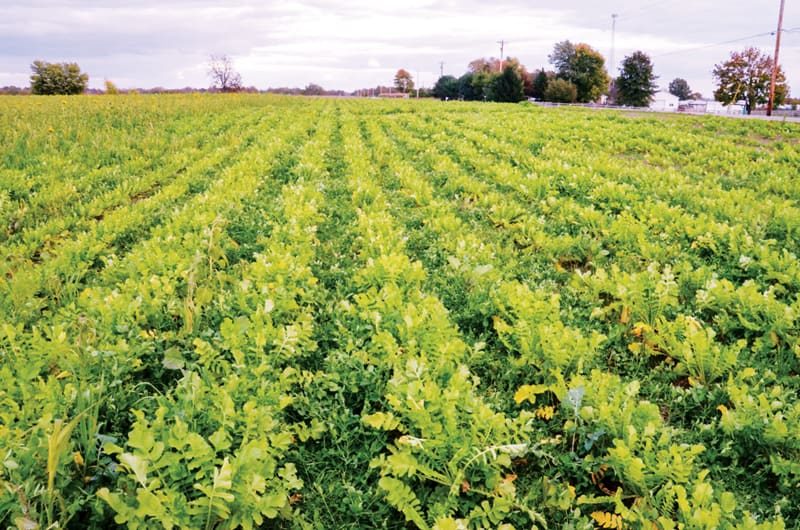






Post a comment
Report Abusive Comment